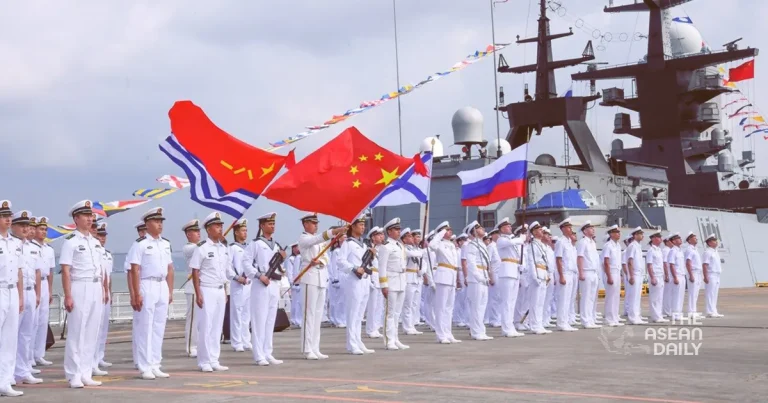17-7-2024 (BEIJING) China and Russia have embarked on live-fire naval exercises in the contentious South China Sea. The joint drills, codenamed “Maritime Cooperation – 2024,” mark a significant milestone in the strengthening of military and trade ties between the two nations, which have intensified in recent years following United States sanctions on both countries.
According to reports from Russian and Chinese state media, the opening ceremony of the “Maritime Cooperation – 2024” exercise took place at the Chinese port of Zhanjiang. The Russian Defense Ministry, via the Telegram messaging app, outlined the objectives of the sea maneuvers, which include joint air defense exercises and anti-submarine drills involving the naval anti-submarine aviation of the People’s Liberation Army (PLA).
For these three-day exercises, both countries have deployed at least three vessels each, as reported by China’s state-controlled Global Times newspaper, citing the PLA Navy. The Russian Pacific Fleet and the PLA Navy crews will collaborate in conducting various maritime operations, showcasing their combined capabilities.
In a demonstration of firepower, Russia’s RIA state news agency reported on Tuesday that the Russian Navy and the Chinese Navy conducted live artillery firing as part of the joint drills. This live-fire component underscores the commitment of both nations to enhancing their operational readiness and interoperability.
Wang Guangzheng of the PLA Navy’s Southern Theater Command emphasized the significance of these joint exercises, stating that “the China-Russia joint patrol has promoted the deepening and practical cooperation between the two in multiple directions and fields.” He further acknowledged that the drills have “effectively enhanced the ability of the two sides to jointly respond to maritime security threats.”
The participating vessels set sail from the naval port in Zhanjiang, located in southern China’s Guangdong province, on Monday. While the specific location of the drills within the contested South China Sea has not been disclosed, the exercises themselves underscore China’s assertive stance over its claimed control over almost the entire region, including the disputed Second Thomas Shoal.
The rising tensions in the South China Sea have prompted US officials to reiterate their ironclad mutual defense treaty obligations with the Philippines, which maintains a presence on the Second Thomas Shoal through a grounded warship, reinforcing its maritime claims in the face of Chinese assertions.
The joint naval exercises are a manifestation of the “no limits” partnership declared by China and Russia in 2022, when President Vladimir Putin visited Beijing just days before launching the invasion of Ukraine. Despite international condemnation, China has refrained from condemning the invasion and has stepped up its exports to Russia, effectively supporting Moscow’s war economy.
This strategic alignment has yielded significant economic dividends, with two-way trade between China and Russia reaching a record high of $240.1 billion in 2023, marking a 26.3% increase from the previous year, according to Chinese customs data. Conversely, China’s trade with the United States declined by 11.6% last year, totaling $664.5 billion.




